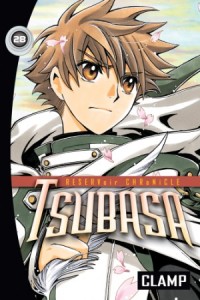By Kaori Yuki. Released in Japan as “Tenshi Kinryouku” by Hakusensha, serialized in the magazine Hana to Yume. Released in North America by Viz Media.
It’s worth noting that this came out in the mid-to-late 90s in Hana to Yume, which these days is better known as the home of series like Oresama Teacher and Skip Beat!. It evolved rapidly in the early years of the 21st century, because back in the late 80s-early 90s there was a lot more darkness and a lot more androgyny in the magazine. And one of the best examples of this is Kaori Yuki’s Angel Sanctuary, a 20-volume series about angels, demons, impossible relationships, and above all strange things happening so fast the cast cannot get proper time to angst (but they manage to work it in anyway).
First of all, yes, as my Manga Bookshelf colleagues have noted, this first volume is a bit tedious at times. There’s a lot of setup, a lot of putting pieces in place, and a lot of backstory that really doesn’t make much sense. We also don’t get enough time to like Sara’s friend as herself before she’s immediately possessed/killed/whatever. That said, I think that the volume manages to succeed anyway, almost entirely on mood. Everything is tense here as we wait for horrible things to happen to our lead, Setsuna, who is a typical troubled teenager with an atypical love for his sister, Sara. He’s having enough trouble trying to shut out his own lustful desires, he really does not need folks coming down and saying he’s the reincarnation of an angel. In fact, his hotheaded and impulsive personality is very reminiscent of a shonen protagonist. But boy, is he in the wrong series.
I mentioned the incest elements, and it’s worth noting how they’re handled. Given that here in 2013 there is an overabundance of incest in almost every manga or anime designed for the otaku, you’d think it would lose its thrill. But this is not here to titillate. Setsuna’s feelings are powerful and deep, and they horrify him. I loved that the first thing he did was check the family register to make sure that one of them wasn’t secretly adopted – he’s read other shoujo manga, I see! But no, he doesn’t get an out that way. And of course Sara feels the same way, though I don’t think either of them is quite aware of the depths of their love just yet. It helps that, familial relationship aside, they make the cutest couple in the book – which, to be fair, is not about romance. Well, not shoujo schoolgirl romance anyway.
The art is another strong point here – at times, it’s the only humor in the series, and I love some of Setsuna’s facial expressions and asides. Given that the series is about angels and demons, there’s also a lot of androgyny on display here, and I guessed wrong about the gender of two of the characters TWICE before nailing it down. (Kurai and Arachne also provide much needed humor here, I should note.) But overall, if I was to use a word to describe this series, it would be overdramatic. And I don’t necessarily mean that just in a bad way. It’s a great series for teenagers – particularly, I think teenage girls would eat this up – as everyone is pretty and your forbidden love is, literally, the end of the world.



